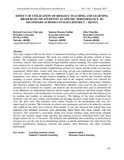| dc.contributor.author | Ong’amo, B. L. | |
| dc.contributor.author | Ondigi, S. R. | |
| dc.contributor.author | Omariba, Alice | |
| dc.date.accessioned | 2019-09-03T12:52:14Z | |
| dc.date.available | 2019-09-03T12:52:14Z | |
| dc.date.issued | 2017-01 | |
| dc.identifier.issn | 2411-5681 | |
| dc.identifier.uri | http://hdl.handle.net/123456789/4345 | |
| dc.identifier.uri | https://www.ijern.com/journal/2017/January-2017/21.pdf | |
| dc.identifier.uri | https://www.semanticscholar.org/paper/Effect-of-utilization-of-biology-teaching-and-on-in-Ong%27amo/0f6c0c51bd1824f1b2df27d69a420bb52f8e4a2b | |
| dc.description | Vol. 5 No. 1 January 2017 | en_US |
| dc.description.abstract | This study sought to find out the effects of utilization of biology teaching and learning resources on
students’ academic performance. The study was carried out in public secondary schools in Siaya
District. The researcher used a sample of twenty-three schools drawn from ninety two public
secondary schools. They were selected through stratified random sampling. The teacher respondents
were purposively or randomly sampled. Purposive sampling was used to choose an experienced
teacher where two or more teachers taught biology in form two classes and the teacher was the most
experienced. Where there existed more than one long serving and experienced teachers teaching
form two classes, random sampling was employed to pick one of them for interview. Student
respondents were chosen through random sampling in single sex schools and stratified random
sampling in mixed schools. Headteachers from each of the sampled schools were selected for
personal interview. The data were collected using questionnaires, checklists, observation schedules
and interview guides for headteachers. Observation schedules were used by the researcher to
ascertain use of resources by teachers and learners and the resultant tests used to determine the
score differences in achievement between classes taught using resources and those taught without
resources. Interviews with headteachers of schools were used to countercheck the information given
by teachers and students on utilization of resources. The findings of the study established that
textbooks were the most widely used teaching and learning resources while audio visual resources
were the least used. The resources were mainly bought by the headteachers and very few
improvised by teachers. The textbooks in schools were inadequate and had to be shared by students
who could not buy their own or borrow from friends. It was also observed that schools that were
endowed with abundant resources were performing much better than those schools with few
resources. The researcher’s assessment during live lesson teaching using observation schedule
showed that students taught using teaching and learning resources performed better than those
taught without the use of resources. The research also established that availability or utilization of
resources was not the only factor determining student’s academic performance but other factors like
teacher’s qualification, pedagogy, attitudes and students entry behaviour also affect academic
performance. | en_US |
| dc.language.iso | en | en_US |
| dc.publisher | International Journal of Education and Research | en_US |
| dc.subject | Learning resource centre Improvisation Student Centered Learning; Resource based learning | en_US |
| dc.title | Effect of utilization of biology teaching and learning resources on students' academic performance in secondary schools in Siaya District - Kenya. | en_US |
| dc.type | Article | en_US |

